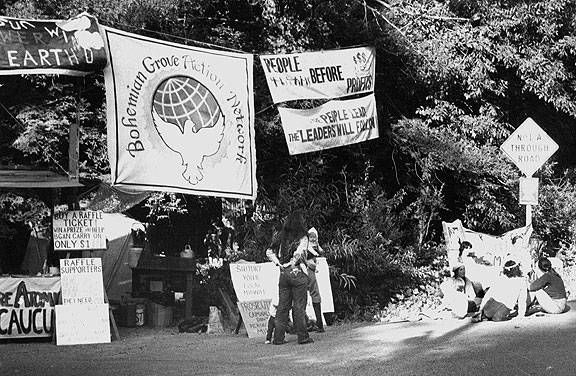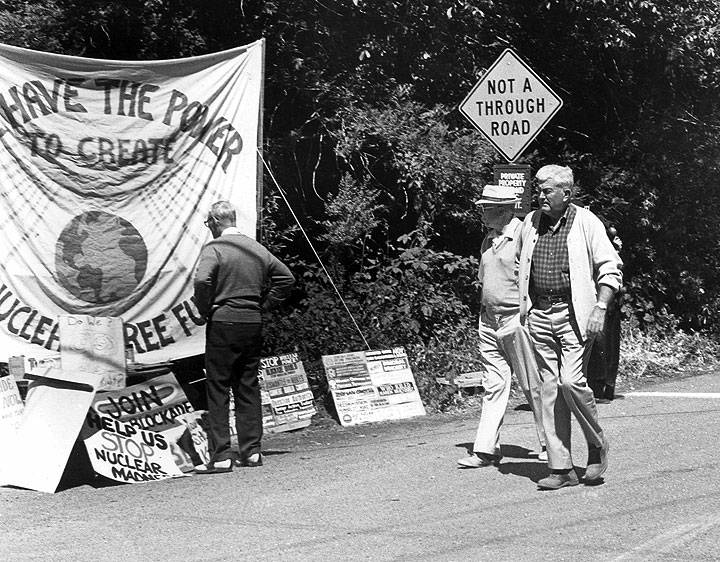Bohemians Ballyhooed at Grove Gathering
Historical Essay
By Mark Evanoff
Originally published in “It’s About Times,” the Abalone Alliance newspaper, September-October 1982, p. 9
As Mercedes, BMWs and Cadillacs carried the corporate elite to their annual frolic at the Bohemian Grove, a group of people claiming to be the real Bohemians stood outside the gates and waved to the men in the passing cars. The Bohemian Grove Action Network (BGAN) was holding a "counter Grove" from which to publicize corporate and government responsibility for the deterioration of the quality of life.
Protest at gates of Bohemian Grove, the exclusive camp with its clubhouse in San Francisco, but its retreat in Sonoma County.
Photo: It's About Times newspaper
Although the Bohemian Club calls itself a "non-profit mutual benefit corporation" which "does not involve itself in political matters," its members' include both corporate wheeler-dealers and top government officials. This year Henry Kissinger spoke to the Bohemians, reassuring them that although the world is in turmoil, the United States can retain its influence through "decisive action."
William Webster, director of the FBI, talked about the importance of more surveillance in the United States. Paul Volker, President of the Federal Reserve Board, promised that the economy would right itself in a year and a half.
German Prime Minister Helmut Schmidt, who came to the Grove to soothe troubled relations between the US and its NATO ally, was not warmly received when he stressed the importance of detente and advised that the United States begin to realize the importance of getting off a war footing.
Despite the seriousness of these matters, waiters inside the Grove told BG AN that many Bohemians were often too drunk to walk. One said that the attitude seemed to be, "eat, drink, and be merry, for tomorrow we will die—which to these guys means being removed from power."
This waiter, one of several who supplied information to the demonstrators, was appalled at the corporate leadership. "The head lemmings are all drunk and leading us over a cliff without knowing what they're doing."
Bohemian Grove campers walk by protest camp at gate.
Photo: It's About Times newspaper
For two weeks, members of BGAN maintained a 24-hour presence outside the gates. As a matter of policy, they were open and friendly to everyone passing by, including the Bohemians themselves. BGAN believes that this policy created an atmosphere in which people from the community, workers at the Grove, and the Bohemians could talk to each another. It made Grove workers comfortable enough to supply information and literature taken from inside the Grove to members of BGAN.
This year, BGAN succeeded in sneaking four people into the Grove. A Time magazine writer and a National Public Radio reporter posed as waiters, and a Time photographer accompanied by a BGAN member hiked in through the countryside, slipping into the grounds by posing as Bohemians. The Time photographer caught Kissinger during his speech, and the writer did a feature article on the Grove. The story was approved for publication by Time's Western bureau chief, but killed in New York.
The NPR reporter was able to tape a number of the speeches, but NPR at first refused to make the tapes available to BGAN, although they had agreed to do so in exchange for help in getting into the Grove. NPR did eventually give BGAN a copy.
According to Bohemian Club policy, business is never supposed to be discussed inside the Grove. Every encampment begins with corporate officials dressed in red robes burning an effigy of "Care," after which the fun is to begin. This year a proposed amendment to the Civil Rights Act by the American Bar Association threatened the privacy of the Club. The response from the Bohemians showed that more than fun takes place during the annual encampments.
One letter circulated in the Grove by the Bohemian Club's directors warned, "No more business talks over a friendly drink. Unless of course, you are willing to have your club open its doors to everyone -- regardless of the club members' wishes." Under pressure from Club members, the American Bar Association dropped the resolution two weeks after the end of the encampment.
These letters to the editor on the same event were originally published in “It’s About Times,” the Abalone Alliance newspaper, September-October 1982
GROVE AND SERIOUS MATTERS
Dear Friends:
While I appreciate the energy that the Bohemian Grove Action Network put into getting people up to Monte Rio to bring some attention on the Bohos and their enclave, I am critical of certain aspects of the action. They illuminate some problems I've encountered before with Livermore Action Group and Abalone Alliance actions.
The first situation deals with the role of monitors. At the "welcoming reception" for the Bohos, we started off by lining the road that leads into the Grove. After a while a monitor told a group of us to move over to the other side of the road so we could stretch along it (to make it appear there were more of us?) and so as not to force traffic to slow down. .
Now, without judging its merits, the question arises as to whether this is a decision that the monitors should have made on their own. I told the-monitor I didn't think it was, but by this time most people had responded to this "request" by moving to the other side of the road.
We asked who had decided this and were told that it was the monitors’ collective. I went looking for two friends who were monitors to question them on the propriety of this decision. They informed me that had been opposed to the monitors making such a decision, and that only 5 of 20 organizers had been involved in it. So, it was not only good process that was missing, but also honesty on the part of the monitor with whom I had initially spoken.
I didn't get the monitor's name, which is something I usually do when dealing with an authority. I am angry that I now feel that this is something I should do with someone who's supposed to be in the same camp. I also resent having to deal with this sort of bullshit when the idea of being there was to confront the Bohos.
The group of people assembled was not so large as to make it impossible for a council to decide whether or not it made sense for us to be on one or both sides of the street. The issue was not quite as important as is the way the decision got made. Also, I believe people should examine the quickness with which they responded to the suggestion (or order?). Aren't we supposed to be taking back control over our lives?
The second situation is somewhat more elusive and so I can only share some reflections that I've had. I was quite surprised to encounter the almost carnivaI-like atmosphere at Friday's welcoming reception. Bidding Bohos to "have a good time" when such a good time means more deadly plans seems as if we're taking "open and friendly" a bit too far!
It seems the more I encounter the non-violence code and the way it is used, the more WASPish it seems. By this I mean cold, sterile, intellect dominating over emotions. The code is devoid of passion. There is no place in the code for anger, rage or love. Any passion which arises in actions is viewed as a violation of the code, and indeed it is. I don't know about you, but it is both love and rage which inspire me to act. A movement which denies these basic feelings seems to be missing a fundamental source of energy.
It is possible that people's anger so scared them that in order to offset its depth they responded by being saccharinely sweet. Are we afraid that if we express our anger at these people and their actions that we will be driven to violent actions? I don't believe that violence has to result from expressing heartfelt anger. We must work towards ways we can honestly and passionately express ourselves through non-violent actions if we are truly to get anywhere in this struggle of ours.
With love and rage,
Geoff Yippie
S.A.B.O.T. affinity group
EXAGGERATED NICENESS
Dear IAT,
My recent experiences at the June 21 Livermore blockade and the Bohemian Grove action in mid-July have brought to mind some important inconsistencies and differences in the way people in our movement view non-violence.
After Livermore the most common complaint I heard from other participants was that certain individuals or groups were "violent." The meaning of violence jn these cases was anything from chanting and questioning the guards' authority to women loving women. While people were so quick to criticize each other, there seemed to be very little anger directed towards the system, where it belongs.
Before recovering from the impact of this in-movement fighting, I went to the Bohemian Grove only to find people taking the "open and friendly" aspect of the non-violence guidelines to an extreme -- perhaps in reaction to Livermore? The action was set up to be a "greeting of the Bohos." As the Bohos drove by in their Cadillacs, many of the demonstrators smiled and waved at them, and some yelled out "Have a nice time!" or "We love you!"
This exaggerated niceness upset me in the pit of my stomach. It felt like conf1ict was being avoided at all costs, and anger was being repressed and denied. How can we justify blockading workers at Diablo and Livermore, and then at the Bohemian Grove -- when we're face to face with the men in power, the nuclear mentality personified -- all that can be mustered up is a friendly smile and wave? And how can we justify being so hard on each other, while being so afraid to point our fingers at the real policy-makers of violence?
-- Rachel
Spiderwomen Affinity Group


